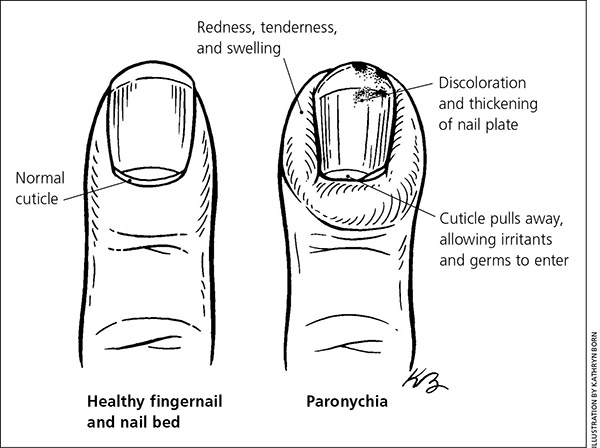
Am Fam Physician. 2017;96(1):online
See related article on paronychia.
What is paronychia?
Paronychia (pair-oh-NICK-ee-ah) is a common problem that affects the nail folds of the fingers and toes. There are two kinds of paronychia: acute and chronic. Acute paronychia happens quickly from an infection in the nail fold. Chronic paronychia is swelling that lasts longer than six weeks. It's caused by irritation from chemicals that enter the nail fold after the normal protective barriers are damaged (see drawing).
Who gets it?
People who have their hands in water a lot are at risk. This includes house and office cleaners, laundry workers, food handlers, cooks, dishwashers, bartenders, chefs, nurses, and swimmers. People with diabetes and those who take certain medicines (such as drugs for HIV) also are at risk.

How do I know if I have it?
Some symptoms of paronychia are:
Redness
Tenderness and swelling
Fluid under the skin around your nails
A thick, discolored nail.
How is it treated?
Your doctor will tell you what kind of medicine is right for you. He or she might want you to use a steroid cream or take pills. If you have very bad paronychia, you might need minor surgery to drain the infection and help the nail fold heal.
What can I expect?
Acute paronychia goes away within a few days once the infection is treated. Chronic paronychia can take weeks to months to go away. Keep using your medicine until your doctor tells you to stop.
What can I do to keep it from coming back?
Here are some things you can do:
Avoid putting your hands in water or chemicals for long periods.
Use lotion every time you wash your hands.
Wear rubber gloves with cotton liners when your hands will be in water or chemicals.
Do not suck on your fingers.
Avoid nail trauma (such as manicures, nail biting, artificial nails).
Where can I find more information?
Your doctor
National Library of Medicine